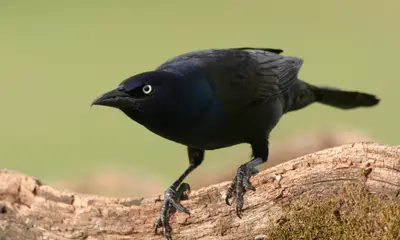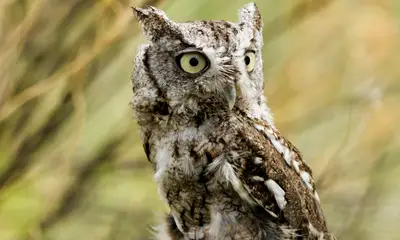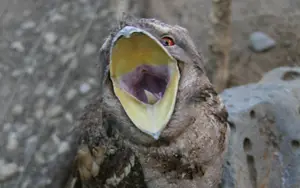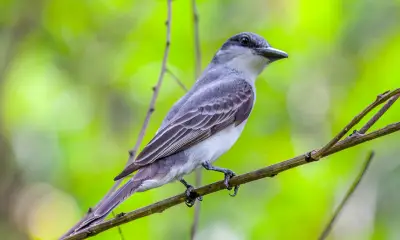Orioles in Arizona
3 Types Of ORIOLES In Arizona (ID Guide With Photos)
Did you recently come across an oriole bird in Arizona, and want to know what species it was?
Identifying orioles in the Grand Canyon State is not as easy as it might seem, since there are several oriole species in Arizona.
To help you identify the bird you saw, we’ll cover the most common orioles of Arizona in this article.
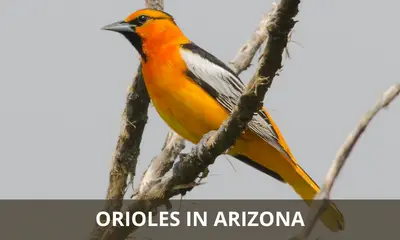
What are the types of orioles in Arizona?
The 3 types of orioles that live in Arizona are:
- Bullock’s Oriole
- Hooded Oriole
- Scott’s Oriole
All of these orioles are summer visitors in Arizona, breeding in the state from March through August, and spending the winter in Central America.
Now let’s dive into the details, and take a closer look at each of these birds:
Bullock’s Oriole
Scientific name: Icterus bullockii

Bullock’s Oriole is a species of the arid plains of western North America, and breeds throughout Arizona.
Just like the other two oriole species in the state of Arizona, it is a migrant, and spends the winter in Central America.
Adult males are flaming orange coupled with a jet black back and a black neck. They also have a large white patch on the wing, and an orange face with a black throat.
Juveniles and females are more grayish-yellow with orange on their face and chest.
Bullock’s Orioles prefer open woodland habitats with cottonwood trees, where they forage for food on the upper branches of trees and shrubs, searching for fruits and insects.
They build remarkable hanging nests by weaving together dried grass and twigs. They are also able to hang upside down for extended periods while they build their nests and forage in trees.
You can most often encounter Bullock’s Orioles in the Grand Canyon State in areas with woodlands close to rivers and streams, as well as in parks and orchards.
Related: Types of black birds in Arizona
Hooded Oriole
Scientific name: Icterus cucullatus

The Hooded Oriole is a breeding bird in central and southern Arizona.
In their original habitat they prefer desert woodland with sycamores or cottonwood trees, but in recent years they have adapted more and more to urban habitats, where they often nest in palm trees.
The Hooded Oriole is a medium-sized bird that is highly conspicuous due to its flaming yellow belly and neck. In addition to these bright parts, its throat, back, tail, and wings are jet black.
In spite of their bright colors, these orioles can be hard to spot, as they like to remain hidden in dense foliage of the trees that they forage in.
These orioles build a woven nest that is attached to the underside of a tree branch. This design helps to protect the nestlings from larger predators (though not from snakes).
The range of the Hooded Oriole in the Southwest has expanded as a result of both an increase in the number of palm trees and an increase in the availability of nectar bird feeders.
Hooded Orioles also feed on nectar directly from flowers, and are considered “nectar robbers,” as they pierce the base of a flower to drink its nectar, and do so without assisting it with pollination.
One of the favorite foods of this bright yellow Arizona bird is nectar, and as a result, they are on occasion observed at bird feeders in Arizona that offer nectar or grape jelly.
They also visit fruit feeders that offer orange slices. But if you try this out, make sure to remove old orange slices, as they quickly become moldy and toxic to birds.
They are migratory birds that can be seen in the state from March to September.
However, due to the increasing availability of feeders, some Hooded Orioles can be observed wintering in southern Arizona, even though they would normally spend the winter in Mexico.
Scott’s Oriole
Scientific name: Icterus parisorum
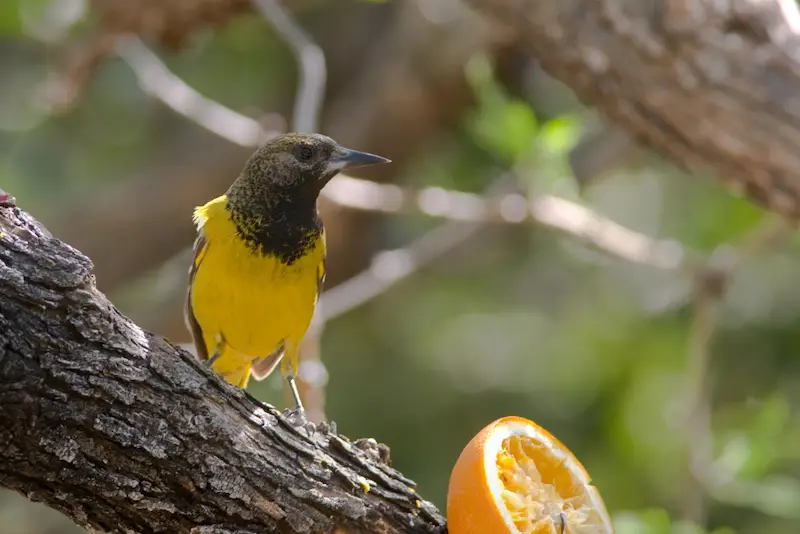
Scott’s Oriole is commonly found in the Southwestern part of the United States, and is a common bird in central and west Arizona.
It is a medium-sized oriole that is highly conspicuous due to its flaming yellow underside.
However, only the lower part of this Arizona bird is yellow in color. Its head, back, breast, tail, and wing are a stunning jet black color.
A type of icterid, it is most famously known as the desert or mountain oriole, as it prefers to live in high desert regions or along mountain slopes in Mexico and Central America, as well as the southern United States.
The Scott’s Oriole frequents both dense oak forests, as well as more open landscapes with scattered trees and yucca plants.
The favorite food of this oriole is yucca nectar. As a result of this, they are on occasion observed at bird feeders offering nectar (or sugar water) in Arizona.
Interestingly, the Scott’s Oriole is one of the few bird species that can eat monarch butterflies, and feeds on monarchs in its winter range in southern Mexico.
Monarch butterflies use toxins from milkweed plants to defend themselves against being eaten by birds, but Scott’s Orioles are able to overcome this defense.
Conclusion
And there we have the orioles found in the state of Arizona.
New World orioles belong to the genus Icterus, and few people know that they are actually more closely related to New World blackbirds than to Old World orioles (even though they look more similar to the latter).
While most species of orioles have a tropical or subtropical range, North America currently has 8 species of breeding orioles, with the largest number of orioles found in Texas.
Interestingly, in many oriole species both the male and the female sing in order to defend their territory against other pairs.
The varied habitats of Arizona are home to more than 500 different types of birds, and orioles make up a significant proportion of this rich avifauna.
These stunningly colorful birds play a vital role in the ecology of their habitats, and were first described in North America by the famous ornithologist William Swainson.
If you enjoyed this article, check out our guide to the birds of prey in Arizona.



